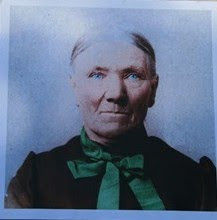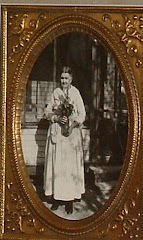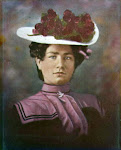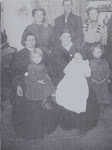 |
| Sarah Goode Marshall Chadwick |
This sketch is written by Luna Chadwick, daughter-in-law and May Chadwick Jones, grand-daughter.
She was born March 2, 1822, in Michaeldeen, England. We have heard her tell about working for the well-to-do families as a girl. When she was middle-aged, the Mormon elders visited their home. She was interested in the principles at once, and began to investigate. She would walk several blocks to get to hear the Mormon elders speak, which caused some disturbance in the home, for her husband was very much opposed to Mormonism.
She was converted and baptized, and to the best of our knowledge, she came from England to America about two years after her husband's death.
She walked every step of the way from New York to Salt Lake Valley, in the year of 1856, pushing a hand-cart all the way. She felt the responsibility of making the journey with six small children, so went to President Young for advice. He said, "Sister Marshall, I promise you in the name of the Lord, that you shall make the journey safely, and not lose one of your children by the wayside. You will live to see them all grow to man and woman-hood". She lived to see her family all grown and with families of their own. One kind man would often take some of the children on his hand-cart to lighten her load. Some days she would have but one pint of flour for herself and six children.
One incident happened that was rather pathetic. When camp was made one evening two of the children were missing. Some men went back to hunt for them and found them sitting down gnawing at some bones they had found.
When they landed in Salt Lake Valley, Sarah and the older girls worked wherever they could find something to do. It was there that she met and married Joseph Chadwick. A son William was born in Slatersville, Utah, October 6, 1857. They moved to Franklin, Idaho, and there Charles Frederick was born in the year 1860, on the 6th day of August. They had many experiences with the Indians while there. Some were friendly, but the greater part were hostile, because they felt that their land was being taken from them.
We have heard Sarah tell that when they would hear the Indians make their war whoops, she would send the larger children with the smaller ones to the school house in the middle of the Fort for protection, a place the women and children often went when they saw approaching danger, while the men were on guard. Many times of an evening the Indians would sneak up and peek in through the windows. They would be so heavily painted, it would give them a big scare. Not a great deal of harm was done, only the stealing of their horses and oxen.
In about the year 1868, the family moved to Dayton, Idaho. They built two log rooms, and had a little store in the north room. They carried groceries, meats, and supplies for the freighters and travelers. They raised cattle and some grain.
In the year 1876, her husband caught a severe cold and died in less than a week.
The Marshall children were grown and married by this time, which left Sarah and the two boys, Will and Fred to make their living the best they could. They kept on with the little store and kept her cows and made butter to sell.
Fred did freighting from Corrinne to Montana when only 17 years old.
Sarah was a staunch Latter Day Saint, and remained so until her death. We remember her asking for the sacrament to be brought to her home after a sick spell, saying it always gave her strength. She lived quite close to our home and we have known her to be called out as much as four times in one night for sickness. She was a good mid-wife and helped bring dozens of babies into the world.
She was exceptionally good to the poor. One of her pet sayings was, "I never gives a happle where there's a horchard" and her every day life proved that that was her actual feeling. She never failed to have some little thing, such as licorice, peppermints or a handful of nuts or raisins in the house to give to her grand-children as well as all other children.
She had a very pleasing disposition, always trying to make peace in place of confusion. She was a good house-keeper and cook. She could beat the world making bread and did never waste food or anything else. She would be imposed upon, rather than take advantage of others, and held to the golden rule, "do to others as you would have them do unto you".
We don't know how large a family there was of them, but told of her brother Fred who roamed a great deal. He went to Australia, as he was a miner, and went where-ever he thought there might be some prospecting to be done.
It was while he was in Canada that he advertised for his sister, Sarah. Her daughter, Scelena [sic]saw it in the paper and she brought the clipping from the paper to her mother. Then Fred who lived near his mother, took care of her business answered the advertisement. Sarah and Fred Goode corresponded for some length of time.
She believed from the first that he was her brother, but wanted to prove it beyond a doubt. These letters were a test. She asked many questions of their childhood days, and of certain incidents that happened while she lived in England. They had been parted 45 years, and when she was convinced, she invited him to her home in Dayton, Idaho. He came and partook of her hospitality as long as she lived, which was three or four years.
Sarah was no hand to put on a big show. We loved her for what she really was. Her health was unusually good. She looked after her garden, her cow and chickens up to the last. We well remember of one sick spell she had when her great faith and the administration of the elders restored her to health. Her children all but the two oldest were with her when she died on the 23rd of April 1904, and was buried in Franklin.
**********************
Georgia Drake Publishers Note: It is known that Brigham Young was in Salt Lake City, Utah when Sarah and her children were preparing to come to America. However, there were other LDS Missionaries during the time Sarah would have been considering the journey to America with the last name Young in England. It is apparent Sarah would not be referring to President Brigham Young. Sarah's brother Fred referred to in this history would be her younger brother George Frederick Goode born in 1835. Out of the fourteen children of George and Selena Goode, apparently four or five left England and came to America. Patience arrived in Salt Lake with her husband John Herbert the same year as Sarah and Mariah though they left England a year earlier. Patience's history mentions a brother that traveled with them and eventually went to the LDS colonies in Mexico. She does not mention a name. There are two men in this family whose death place is not indicated, George Frederick and an older brother Samuel Goode. I have had no luck as yet verifying a sibling going to the Mexico colonies.
This traveling group from England rode by train to Iowa City. Here they were outfitted with handcarts and began their trek to Salt Lake City by foot.
________________________
Transcribed as written by Luna Chadwick, wife of Charles Frederick Chadwick (taken from her original personal papers) and a grand-daughter of Joseph Chadwick, May Chadwick Jones.

















